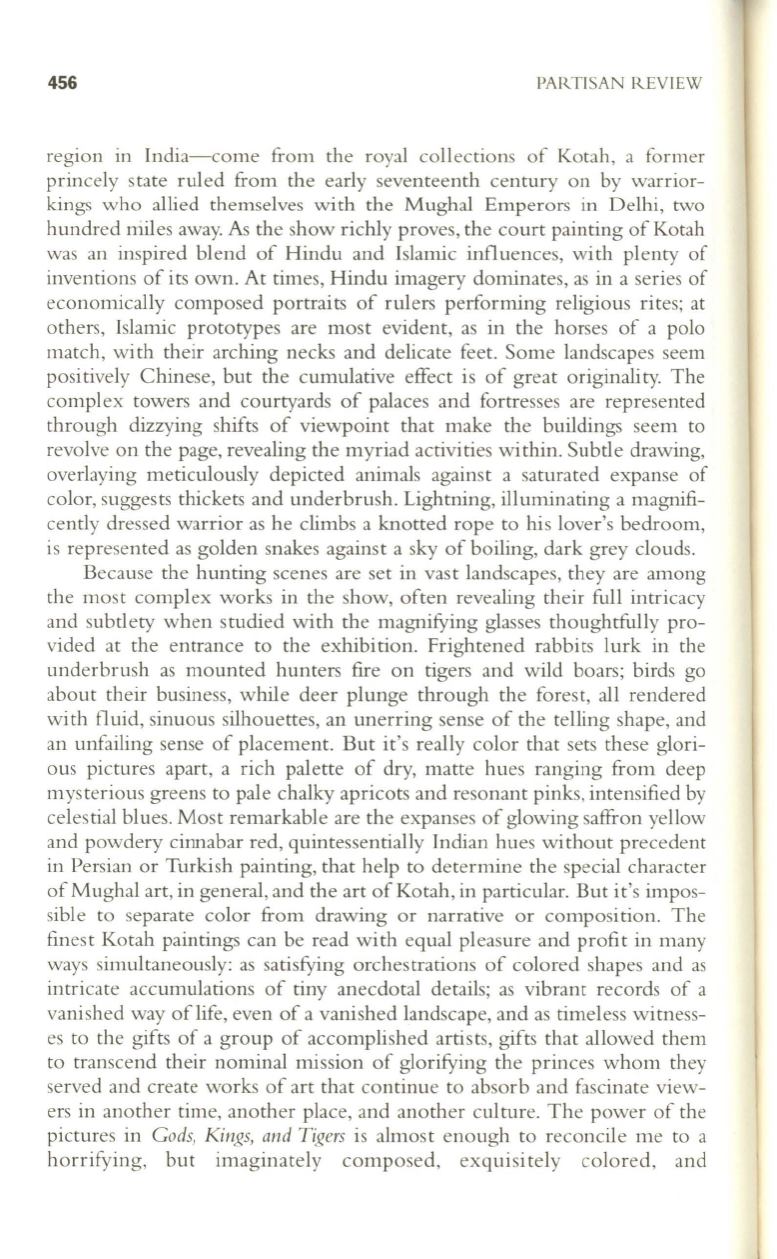
456
PARTISAN REVIEW
region in India-come from the royal collections of Kotah, a former
princely state ruled from the early seventeenth century on by warrior–
kings who allied themselves with the Mughal Emperors in Delhi, two
hundred miles away. As the show richly proves, the court painting of Kotah
was an inspired blend of Hindu and Islamic int1uences, with plenty of
inventions of its own. At times, Hindu imagery dominates, as in a series of
economically composed portraits of rulers performing religious rites; at
others, Islamic prototypes are most evident, as in the horses of a polo
match, with their arching necks and delicate feet. Some landscapes seem
positively Chinese, but the cumulative effect is of great originality. The
complex towers and courtyards of palaces and fortresses are represented
through dizzying shifts of viewpoint that make the buildings seem to
revolve on the page, revealing the myriad activities within. Subtle drawing,
overlaying meticulously depicted animals against a saturated expanse of
color, suggests thickets and underbrush. Lightning, illuminating a magnifi–
cently dressed warrior as he climbs a knotted rope to his lover's bedroom,
is represented as golden snakes against a sky of boiling, dark grey clouds.
Because the hunting scenes are set in vast landscapes, they are among
the most complex works in the show, often revealing their full intricacy
and subtlety when studied with the magnifying glasses thoughtfully pro–
vided at the entrance to the exhibition. Frightened rabbits lurk in the
underbrush as mounted hunters fire on tigers and wild boars; birds go
about their business, while deer plunge through the forest, all rendered
with t1uid, sinuous silhouettes, an unerring sense of the telling shape, and
an unfailing sense of placement. But it's really color that sets these glori–
ous pictures apart, a rich palette of dry, matte hues ranging from deep
mysterious greens to pale chalky apricots and resonant pinks, intensified by
celestial blues. Most remarkable are the expanses of glowing saffron yellow
and powdery cinnabar red, quintessentially Indian hues without precedent
in Persian or Turkish painting, that help to determine the special character
of Mughal art, in general, and the art of Kotah, in particular. But it's impos–
sible to separate color from drawing or narrative or composition. The
finest Kotah paintings can be read with equal pleasure and profit in many
ways simultaneously: as satisfying orchestrations of colored shapes and as
intricate accumulations of tiny anecdotal details; as vibrant records of a
vanished way oflife, even of a vanished landscape, and as timeless witness–
es
to
the gifts of a group of accomplished artists, gifts that allowed them
to transcend their nominal mission of glorifying the princes whom they
served and create works of art that continue to absorb and fascinate view–
ers in another time, another place, and another culture. The power of the
pictures in
Gods, Kings, and Tigers
is almost enough to reconcile me to a
horrifying, but imaginately composed, exquisitely colored, and


